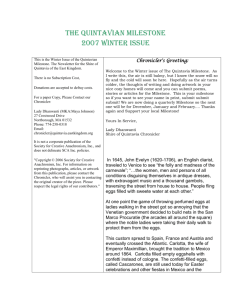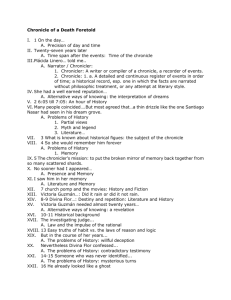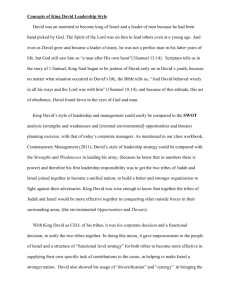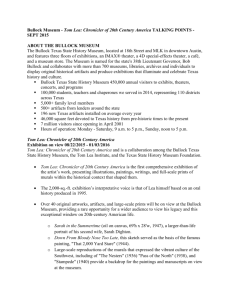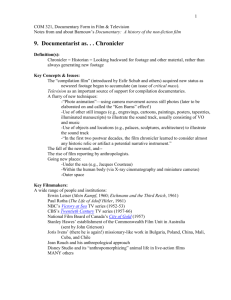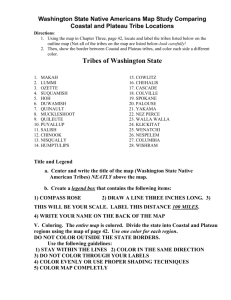The Identity, Privileges and Responsibilities of God`s People
advertisement
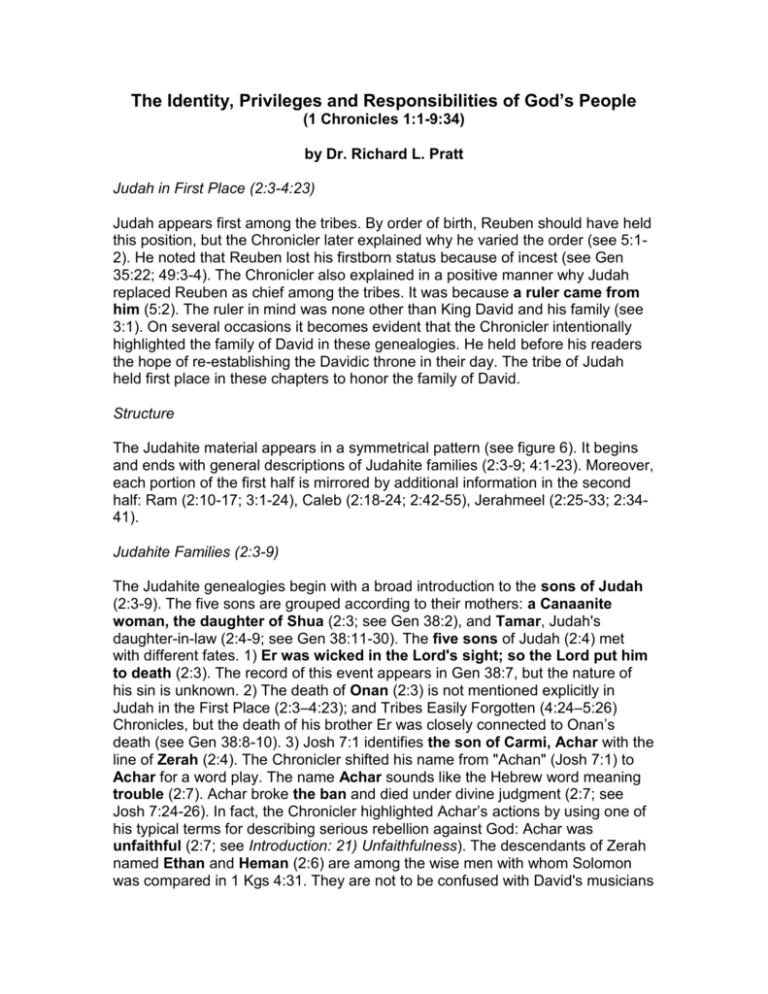
The Identity, Privileges and Responsibilities of God’s People (1 Chronicles 1:1-9:34) by Dr. Richard L. Pratt Judah in First Place (2:3-4:23) Judah appears first among the tribes. By order of birth, Reuben should have held this position, but the Chronicler later explained why he varied the order (see 5:12). He noted that Reuben lost his firstborn status because of incest (see Gen 35:22; 49:3-4). The Chronicler also explained in a positive manner why Judah replaced Reuben as chief among the tribes. It was because a ruler came from him (5:2). The ruler in mind was none other than King David and his family (see 3:1). On several occasions it becomes evident that the Chronicler intentionally highlighted the family of David in these genealogies. He held before his readers the hope of re-establishing the Davidic throne in their day. The tribe of Judah held first place in these chapters to honor the family of David. Structure The Judahite material appears in a symmetrical pattern (see figure 6). It begins and ends with general descriptions of Judahite families (2:3-9; 4:1-23). Moreover, each portion of the first half is mirrored by additional information in the second half: Ram (2:10-17; 3:1-24), Caleb (2:18-24; 2:42-55), Jerahmeel (2:25-33; 2:3441). Judahite Families (2:3-9) The Judahite genealogies begin with a broad introduction to the sons of Judah (2:3-9). The five sons are grouped according to their mothers: a Canaanite woman, the daughter of Shua (2:3; see Gen 38:2), and Tamar, Judah's daughter-in-law (2:4-9; see Gen 38:11-30). The five sons of Judah (2:4) met with different fates. 1) Er was wicked in the Lord's sight; so the Lord put him to death (2:3). The record of this event appears in Gen 38:7, but the nature of his sin is unknown. 2) The death of Onan (2:3) is not mentioned explicitly in Judah in the First Place (2:3–4:23); and Tribes Easily Forgotten (4:24–5:26) Chronicles, but the death of his brother Er was closely connected to Onan’s death (see Gen 38:8-10). 3) Josh 7:1 identifies the son of Carmi, Achar with the line of Zerah (2:4). The Chronicler shifted his name from "Achan" (Josh 7:1) to Achar for a word play. The name Achar sounds like the Hebrew word meaning trouble (2:7). Achar broke the ban and died under divine judgment (2:7; see Josh 7:24-26). In fact, the Chronicler highlighted Achar’s actions by using one of his typical terms for describing serious rebellion against God: Achar was unfaithful (2:7; see Introduction: 21) Unfaithfulness). The descendants of Zerah named Ethan and Heman (2:6) are among the wise men with whom Solomon was compared in 1 Kgs 4:31. They are not to be confused with David's musicians by the same names. 4) Shelah (2:3) is only mentioned in this genealogy (2:3), but his descendants appear in 4:21. 5) By contrast with other descendants of Judah, the family of Perez (2:5,9) steadily increases numerically. As in a number of other passages, the Chronicler noted the increase of progeny to indicate that God had blessed the line of Perez above other families of Judah (see Introduction: 25) Increase and Decline of Progeny). No judgment on his house appears in this text. The Chronicler highlighted this branch of the tribe Judah because it led to David, the great king of Israel. The severe consequences of sin come to the foreground to introduce a guiding principle of his history. Time and again this history will point out that flagrant sins brought swift judgment from God. This motif warned the post-exilic readers against infidelity in their day. In much the same way, the emphasis on the relative purity of the family of Perez revealed the Chronicler’s belief that fidelity to God brought about divine blessing (see Introduction: 10-27) Divine Blessing and Judgment). Descendants of Ram (2:10-17) In line with his special interest in David's royal family, the Chronicler broke with birth order and gave first place to the line of Ram (2:10-17). Jesse (2:12), the father of David (2:15), came from this branch of the tribe of Judah. This text depends on Ruth 4:18-22. It balances with information on Ram's descendants in 3:1-24 (see figure 6). According to 1 Sam 17:12-14 David was Jesse's eighth son, but here he is described as his seventh son (2:15). For some unknown reason, the Chronicler omitted David's brother Elihu, even though he mentioned him in 27:18. In line with the flexible standards for genealogies in the Chronicler's day, Elihu may have been dropped from this list because he died without progeny and was therefore unimportant for the post-exilic situation. Descendants of Caleb (2:18-24) The Chronicler proceeded next to the descendants of Caleb (2:18 [spelled "Kelubai" in 2:9]) which balances with the later notices on this clan in 2:42-55 (see figure 6). This Caleb is not to be confused with the well-known "Caleb son of Jephunneh" (Num 13:6), whom the Chronicler clearly identified in 4:15. As the preceding record of Ram gave the background of David the monarch (2:10-17), the lineage of Caleb provided the ancestry of another important character in the Chronicler's perspective. Caleb was the ancestor of Bezalel (2:20). Bezalel supervised tabernacle construction in the days of Moses (see Exod 31:1-5; 35:30-36:7). The Chronicler focused on the family of this tabernacle artisan to express his belief in the close interconnection between the throne of David and temple worship as central institutions in Israel (see Introduction: 4-9) King and Temple). Descendants of Jerahmeel (2:25-41) The sons of Jerahmeel (2:25-41) stand at the center of the Judahite genealogies. The clan lived in southern Judah (see 1 Sam 27:10; 30:27-29), but this material is the only genealogical information on the family. The Jerahmeelites appear in two separate lists (2:25-33 and 2:34-41; see figure 6), which are distinguished by the summary statement: These were the descendants from Jerahmeel (2:33). The first list (2:25-33) provides a general orientation to the family. Many of these names are common in Scripture, but it is not possible to establish precise identifications. The second list (2:34-41) deals particularly with the family of Sheshan (2:34) and ends with his descendant Elishama (2:41). This final name may provide a clue to the Chronicler's main concern with the Jerahmeelites. If there are no gaps in this genealogy, then Elishama appears near the generation of David. This temporal orientation suggests that he may have been David's contemporary. If this is true, the Chronicler may have wished to honor a family closely associated with David. Then again, because generations are skipped in biblical genealogies without notice, Elishama may have been a scribe of King Jehoiakim (see Jer 36:12,20), or even a contemporary of the Chronicler himself. Whatever the case, the Chronicler felt it necessary to establish Elishama's pedigree as an important Judahite. Perhaps some of his readers questioned the status of this man or his descendants because an Egyptian (2:34) was among his ancestors. As such, the Chronicler demonstrated his inclusive outlook toward foreigners (see: Introduction: 3) International Relations). More on Caleb (2:42-55) The Chronicler moved next to a second record of the sons of Caleb (2:42) which balances with 2:18-24 (see figure 6). This material divides into two sections: Caleb (2:42- 50a) and Hur (2:50b-55). These additional lists emphasize two issues. First, the Chronicler mentioned Ziph, Mareshah, and Hebron (2:42), geographical sites beyond the borders of the province of Judah after the exile. In these geographical passages, "father of" meant "founder of" or "leader of". By mentioning these places, the Chronicler touched on a theme which occurs on a number of occasions. He encouraged his post-exilic readers to expand their geographical hopes to include all the territories once occupied by these Judahites. The prophets had already announced that Israel would repossess the promised land after exile (see Isa 34:17; 57:13; 60:21; Obad 1:17-20). This passage is one among many which reaffirmed these hopes for the Chronicler's readers (see comments on 4:10,11-23,28-43; 5:23; 6:54-81; 7:28-29; 8:1-6,7-13; 9:1b-2; 10:7; 2 Chr 20:7,11; 31:15). Second, this section contains the names of Judahites whose legitimacy could easily have been called into question. They include the children of Caleb's concubines (2:46,48). Moreover, the text also mentions Kenites (2:55), foreigners who were adopted into Judah (see Judg 1:16; 4:11). The Chronicler’s vision of the people of God after the exile included non- Israelite converts as well (see 4:25; 9:2; see also Introduction: 3) International Relations). Such hopes stemmed from earlier prophetic predictions of the same (see Isa 56:6-8; Ps 87; Zech 8:20-32; 14:16). The Chronicler wanted to insure that these questionable people were included among the highly honored people of Judah after the exile. More on Ram (3:1-24) In continuation of the previous genealogy of Ram in 2:10-17 (see figure 6), the Judahite genealogies turn next to the sons of David (3:1): David's progeny born in Hebron and Jerusalem (3:1-9), Solomon's descendants up to the exile (3:1016), and the line of Jeconiah (Jehoiachin) during and after the exile (3:17-24). The steps of this material narrow attention from all of David's children to Zerubbabel who represented the line of David in the early post-exilic period. First, the Chronicler listed David's sons born in Hebron (3:1-4a) and Jerusalem (3:4b- 9), following 2 Sam 3:2-5; 5:13-16; 13:1. These names appear for completeness and to distinguish the descendants of David in general from the special royal line. Second, the Chronicler concentrated on Solomon (3:10-16), the son of David whom the Lord chose to be king. Unlike the book of Kings, Chronicles never reports the struggle between Solomon and Adonijah for David’s throne (see 1 Kgs 1-2). From the Chronicler's perspective, the move from David to Solomon was a smooth transition perfectly conformed to the plan of God (see comments on 23:1). Third, the last portion of David's royal line focuses on the sons of Jeconiah, the captive (3:17-24). Jeconiah, known also as Jehoiachin (see 3:16), is called the captive because he was exiled to Babylon in 597 B.C. (see 2 Kgs 24:12). The prophet Jeremiah, whose writings the Chronicler knew (see 2 Chr 35:25; 36:12,21-22), had announced earlier that God had rejected Jeconiah's family from the royal line (see Jer 22:28-30). This prophecy may have raised questions about Jeconiah's descendants after the exile. Should some other line of David take the throne? In this genealogy the Chronicler affirmed that God had lifted his curse and re-established Jeconiah's line as the object of Israel's future royal hopes. Jeconiah himself was released from prison in Babylon (see 2 Kgs 25:27-30). His descendant, Zerubbabel (see 3:19), was the leader of the early post-exilic community (see Ezra 3:1-13). In fact, God declared that Zerubbabel would be like his "signet ring" (Hag 2:23), directly reversing the curse on Jeconiah (see Jer 22:24). Zerubbabel never became king, but the Chronicler ended his royal genealogy with a focus on Zerubbabel (see 3:19-24). His line represented the only legitimate royal family for Israel after the exile. Interestingly enough, both Matthew and Luke agreed with the Chronicler and identified Jesus with Zerubbabel's lineage (see Matt 1:12-13; Lk 3:27). It should be noted that the Chronicler designated Pediah (3:18) as the father of Zerubbabel (3:19). Elsewhere, Zerubbabel is called the son of Shealtiel (see Ezra 3:2,8; Neh 12:1; Hag 1:12,14; 2:2,23; Matt 1:12; Luke 3:27). Pediah may have become the head of Zerubbabel's family at Shealtiel's death, adopting Zerubbabel as his own son. Otherwise, Pediah may have married Shealtiel's widow through levirate marriage (see Deut 25:5-6), making Zerubbabel the legal son of Shealtiel. Interpreters have disagreed over the number of generations which appear in 3:21b-24. The main point of controversy is the sequence: of Rephaiah, of Arnan, of Obadiah and of Shecaniah (3:21). Some interpreters have taken these names as representing more sons of Hananiah (3:21; see RSV, NRSV). Others see them as four contemporaries of Zerubbabel (see NIV). It is unclear, therefore, how far this genealogy extends beyond Zerubbabel. In the least, it reaches two generations beyond him: the sons of Zerubbabel (3:19b), and the descendants of Hananiah (3:21a). Unless this genealogy was updated at some stage during the transmission of Chronicles (see Introduction: Translation and Transmission), this passage indicates that the Chronicler could not have written before the births of Zerubbabel's grandchildren. This limitation, however, does not eliminate the possibility of an early date for composition during Zerubbabel's lifetime so long as we remember that his grandchildren had been born (see Introduction: Authorship and Date). More on Judahite Families (4:1-23) The Chronicler closed his Judahite genealogies by returning to broad lists of the sons of Judah (4:1-23) in balance with 2:3-9 (see figure 6). Personal and clan names are mixed with place names. This material divides between Perez (4:120) and Shelah (4:21-23). Within his record of Perez's descendants (4:1-20), the Chronicler introduced the first of four brief narratives in his genealogies (4:9-10; see 5:18-22,24-26; 7:21-24). This narrative begins with an authorial comment (4:9) followed by a two step scenario: Jabez prays (4:10a) and God answers (4:10b). The presence of the name Jabez in the line of Perez apparently raised a difficulty for the Chronicler. Perez was the ancestor of David whose lineage the Chronicler wanted to exalt. Nevertheless, the name Jabez means "pain" in Hebrew, hardly a flattering name to include in such an exalted lineage. For this reason, the Chronicler introduced his story with the explanation that Jabez was more honorable than his brothers (4:9). His name did not reflect his character. Instead, his mother gave him this name because she bore him in pain (4:9). The reputation of the line of Perez remained intact. To demonstrate how honorable this man was, the Chronicler related a story of prayer (4:10). Jabez prayed that God would enlarge [his] territory ... and keep [him] free from harm and pain (4:10a). The Chronicler closed the episode by simply noting that God granted his request (4:10b). God established Jabez's honor by answering his prayer. Jabez's prayer related directly to the needs of the Chronicler's original readers in at least three ways. First, the Chronicler's readers had experienced much pain during and after the exile. They certainly would have identified with Jabez's desire. Second, Jabez’s prayer touched on the issue of expanding the territories of post-exilic Judah. (For the Chronicler’s geographical hopes see 2:42-55.) Third, the Chronicler pointed to Jabez as an example of an appropriate way to gain relief from suffering and territorial expansion. Jabez prayed, “Let your hand be with me” (4:10). In the Chronicler’s vocabulary for God to be “with” someone was for him to aid them in their struggles and to fight for them (see 2 Chr 13:12; see also Introduction: 10) Divine Activity). Sincere prayers to God for his help were essential for the post-exilic community to receive these kinds of blessings (see Introduction: 17) Prayer). The remaining verses of the Judahite genealogies (4:11-23) are fragmentary and difficult to interpret. Yet, two items warrant comment. On the one hand, the passage focuses on trade guilds among Judahites. The clans of the linen workers (4:21) and the potters who ... worked for the king (4:23) probably appear to encourage the post-exilic descendants of these Judahites to take up their ancestors' trades again. On the other hand, these lists mention several locations in and around Judah to encourage the readers once again to expand their territorial hopes (For the Chronicler’s geographical hopes see 2:42-55.). As we have seen, the Chronicler set the tribe of Judah at the head of Israel. He pointed out several remarkable people in this line. Yet, his primary concern was to establish the importance of the Davidic throne. The post-exilic people longed for the blessings of God, but in order to receive them, they had to devote themselves to the royal line of David represented by the family of Zerubbabel. Ignoring or rebelling against this divine order would surely bring further ruin. Without David's family at the head of the nation, the Israelites would never receive the glorious kingdom they had been promised. Tribes Easily Forgotten (4:24-5:26) Having given Judah first place among God's people (2:3-4:23), the Chronicler turned next to four tribes which could easily have been forgotten in post-exilic times. These four families of Israel were not as important as Judah, Levi, and Benjamin (see figure 7), but they were still to be counted among the people of God. Structure This material consists of a variety of lists and genealogies (see figure 6). It divides into two sections marked by the closing words, to this day (4:43; 5:26). The first portion focuses on the tribe of Simeon (4:24-43); the second portion deals with the tribes who lived east of the Jordan River: Reuben, Gad, and the half-tribe of Manasseh (5:1-26). The original readers of Chronicles were prone to exclude these clans from the people of God for at least two reasons. First, few members of the restored community were from these tribes. The returnees primarily included people from Judah, from Benjamin, and from Ephraim and [western] Manasseh (not the Transjordanian "half-tribe of Manasseh") (9:3). The tribe of Levi was also well represented (9:10-34). Naturally, the returnees were primarily concerned with themselves and their nearest kinsmen rather than other tribes. Second, it was easy for the post-exilic community to marginalize Simeon, Reuben, Gad and the half-tribe of Manasseh because they had played relatively minor roles in Israel's history. The four tribes appeared frequently in premonarchical biblical history, but by David's time they were infrequently mentioned (see 1 Sam 13:7; 2 Sam 24:5; 2 Kgs 10:33). From the Chronicler's perspective, however, those who had returned from exile only represented the initial stages of Israel's restoration. He included these less important tribes in these chapters to encourage his readers to hope, pray, and work for their return as well. The Tribe of Simeon (4:24-43) The tribe of Simeon was one of the easiest families of Israel to neglect. From earliest times, Simeon was closely associated with Judah (see Josh 19:1-9; Judg 1:3). The land allotted to the tribe was on the southern border of Judah and was even described as "within the territory of Judah" (Josh 19:1,9). By the time of David, Simeon had completely lost its identity and was simply counted as one with Judah (see 4:27b). Nevertheless, the Chronicler insisted that Simeon was to regain its original status among the tribes after the exile. His record of Simeon divides into three parts (see figure 6). Simeonite Genealogy (4:24-27) Simeon's genealogical record closely follows Num 26:12-14. Similar accounts also appear in Gen 46:10 and Exod 6:15. One interesting feature of this passage is the mention of Mibsam and Mishma (4:25). These names appear to be Ishmaelite in origin and may reflect the absorption of Ishmaelites from the southern desert regions into the tribe of Simeon. As elsewhere, the Chronicler showed interest in foreigners among the people of God (see Introduction: 3) International Relations). He wanted to insure that even the descendants of these foreign converts had a place in the post-exilic community (see 2:55; 9:2). Simeonite Geographical Notices (4:28-33) This list of Simeonite settlements stems from Josh 19:2-8 where it is reported that God gave certain territories to Simeon (see also Josh 15:26-32). In light of Judah's usurpation of Simeonite property before the exile, it is likely that at least some Judahites claimed these lands of Simeon for themselves after the exile. The Chronicler, however, objected because these territories were only secondarily taken by Judah. He commented directly that these were their [Simeonite] towns until the reign of David (4:31b). The family of Simeon was to receive its original inheritance upon return to the land. Simeonite Territorial Expansions (4:34-43) The Chronicler closed his treatment of Simeon by listing some prominent tribal leaders (4:34-37). He also noted how they grew in number and expanded their territories in several directions (4:38-43). The increase of these families indicated that God had blessed them (see Introduction: 25) Increase and Decline of Progeny). Comparisons with Neh 11:26-29 indicate that some of these locations (Moladah, Hazar Shual, Beersheba, Ziklag, Ain, Rimmon ["En Rimmon" in Neh 11:29]) were resettled soon after the exile. Chronicles draws attention to these cities to secure them and other legal possessions of Simeon. The Chronicler noted these Simeonites experienced peaceful and quiet times (4:40). These terms often described his ideal state of blessing (see Introduction: 23) Victory and Defeat). Here he noted that the Simeonites experienced a foretaste of what he hoped his readers would soon experience. The last verses of this section (4:42-43) are particularly telling. They reveal that the Chronicler's interest in Simeon related to his own times. He mentioned that a number of Simeonites had invaded Seir, killed escaping Amalekites, and continued living there to this day, i.e. to the Chronicler's own times (4:43). The expression to this day deserves special comment. This phrase and related expressions appear eleven times in Chronicles. Care must be taken to identify the temporal references of these words. At least three possibilities exist: 1) Sometimes these words were merely copied from written sources (e.g. the book of Kings). In these cases, "to this day" refers to the earlier days of the Chronicler’s literary sources, not to the Chronicler's time (see 4:41; 17:5). 2) On other occasions, the expressions appear in sources (e.g. royal annals used by Kings) used by the Chronicler's immediate sources (e.g. Kings). In these examples, the time reference is to the earlier period of a source used by the Chronicler’s source (see 13:11; 2 Chr 5:9; 8:8; 10:19; 21:10). 3) Even so, as in this verse, "to this day" can also refer to the Chronicler's own time (see 5:26; 2 Chr 20:26; 35:25). The Chronicler closed his record of Simeon's family with this reference to his own day in order to draw a connection between Simeon's past and his contemporary audience. The family of Simeon had not been entirely lost. The post-exilic community could identify some Simeonites, who continued to live in the nearby territory of Seir. As a result, his readers needed to include these Simeonites and their relatives among God's people. The Transjordanian Tribes (5:1-26) The Chronicler was also concerned that his readers remember the tribes that had settled east of the Jordan River. These families were easily excluded from their minds for several reasons. First, longterm geographical separation was a problem. Reuben, Gad, and the half-tribe of Manasseh had received special permission to settle east of the Jordan River (see Num 32; Deut 3:12-20; Josh 1:12-15; 12:6; 22:1-9). Immediately after Joshua’s conquest special arrangements had to be made to insure that they continued to be counted among the tribes of Israel (see Josh 22:10-34). Second, the Transjordanian tribes were subjugated to foreign powers very early during the Divided Kingdom. Hazael of Syria overran their lands in c. 837/6 B.C. (see 2 Kgs 10:32- 91) and the Transjordanians faded even further from participation in national life. Third, the Chronicler mentioned that the Assyrian king Tiglath-Pileser III carried these tribes into exile around 734 B.C., twelve years before he did the same to the other northern tribes (see 5:6,26). Their early exile made it easy to exclude them from the national vision of post-exilic Israel. The Chronicler focused on several concerns related to the Transjordanian tribes. His material divides into five interconnected sections (see figure 6). The Tribe of Reuben (5:1-10) Reuben heads the list of Transjordanian tribes as in many other passages (see Num 32:1; Deut 3:12,16; Josh 1:12; 12:6; 22:1,9-10,13,15,21,25,30-34). This record of the Reubenites includes genealogies (5:1-8a), geographical notes (5:8b-9), and territorial expansion (5:10) much like the preceding Simeonite material. The genealogical section (5:1-8a) first traces the sons of Reuben for one generation (5:1-3). It then mentions the descendants of Joel up to the Assyrian exile (5:4-6). Finally, it lists a number of Reubenite chiefs (5:7-8a). Only the immediate sons of Reuben appear elsewhere in Scripture (see Gen 46:9; Exod 6:14; Num 26:5-6). One of the Chronicler's purposes in these lists becomes evident in the parenthetical comment he inserted into his first genealogy (5:1b-2). Here he explained why the tribe of Reuben had not amounted to much. Reuben was Israel's firstborn. As firstborn son, Reuben was due to receive a double portion of his father's inheritance and should have been the leader of the nation of Israel (see Deut 33:6). However, he received a relatively small portion of land and only played a minor role. In this passage, the Chronicler provided the only direct explanation of this turn of events. He reasoned that Reuben had defiled his father's marriage bed (5:1) and lost the double blessing to Joseph (Ephraim and Manasseh; see Gen 48:1-22; 49:22-26; Deut 33:13-17). For the same reason, Reuben also lost his leadership role to Judah from whom a ruler came, i.e. David and his family (5:2). Despite Reuben's loss of privileges, twice this passage calls him the firstborn of Israel (5:1,3). This repetition suggests that the Chronicler still wanted his original readers to honor Reuben. As was the custom in the ancient Near East, the tribes of Israel were to respect Reuben's biological priority. The family of Israel's firstborn should not be forgotten in the post-exilic period. The Chronicler's record of the descendants of Joel (5:4-6) contains an important historical note on the Assyrian King Tiglath-Pileser III (745-727 B.C.) (5:6). His name is spelled "Tilgath Pilneser" in the Hebrew text of this verse (see NRS, NAS). Near 734 B.C. this Assyrian king took control of the northern kingdom of Israel and deported many Reubenites into exile (see 2 Kgs 15:29). This humiliating historical fact explained why Reuben may not have seemed important to the Chronicler's readers. Even so, in the last portion of this material (5:8b-10), the Chronicler balanced Reubenite humiliation with a record of the tribe's territories. He noted their expansion to the edge of the desert was because their livestock had increased (5:9). The Mosaic covenant identified abundant livestock as a divine blessing for covenant fidelity (see Deut 28:4,11; 30:9). Beyond this, the Chronicler also noted that something remarkable happened during Saul's reign (5:10a). In the early monarchical period, the Reubenites occupied the dwellings of the Hagrites (5:10b). The Hagrites cannot be specifically identified, but they are associated elsewhere with Ishmaelites and Moabites (see Ps 83:6). The Chronicler mentioned this event to show that the Reubenites had received another special blessing from God. Throughout Chronicles victory for Israelites resulted from divine blessing (see Introduction: 23) Victory and Defeat). Reuben found God’s favor and accomplished a significant victory against his enemies. For this reason too, Reuben's descendants should be counted among God's people after the exile (see Introduction: 2) Northern Israel). The Tribe of Gad (5:11-17) The short record of the Gadites (5:11-17) begins with geographical notes (5:1112), moves to lists of families (5:13-15), returns to geography (5:16), and closes with a source notation (5:17). This material is explicitly connected with the preceding Reubenite record by the introductory phrase next to them (5:11). Like Reuben, Gad also had a minor role in the history of Israel after the establishment of David’s throne (see 1 Sam 13:7; 2 Sam 24:5; 2 Kgs 10:33; 1 Chr 2:2; 5:11,16,18,26; 6:63,80; 12:8,14,37; 26:32; see Jer 49:1; Ezek 48:27-28,34). Consequently, the Chronicler sketched the extent of their land to establish the tribe's legitimate territorial claims (5:11- 12,16). He also referred to the source of his material as a royal record (5:17). This record was probably a military census written during the reigns of Jotham ... and Jeroboam (c. 750 B.C.). The Chronicler referred to this military record to demonstrate that the tribe of Gad had a significant role in national life at that time. Gad should not, therefore, be overlooked by the Chronicler's post-exilic readers (see Introduction: 2) Northern Israel). Transjordanian Victory (5:18-22) The Chronicler turned next to the second of four narratives within his genealogies (see 4:9-10; 5:24-26; 7;21-24). This episode focuses on victory in battle for the Transjordanian tribes and stands in sharp contrast with the defeat of Transjordanians later in this chapter (see 5:24-26). These passages illustrate the Chronicler's belief that fidelity will lead to victory (5:18-22) and infidelity to defeat (5:24-26). Similar themes appear time and again in the book of Chronicles (see Introduction: 23) Victory and Defeat). Structure of 5:18-22 This narrative divides into a symmetrical five step pattern (see figure 6). It begins with preparation for battle (5:18) and ends with settlement after war (5:22b). The battle takes place (5:19) and is won (5:21-22a). The turning point of the episode is the prayer and divine intervention (5:20). Transjordanian Preparations for Battle (5:18) The Chronicler began this simple narrative with a description of 44,760 warriors in the combined forces of Reuben, Gad, and the half-tribe of Manasseh (5:18). This scene balances with the closing notice of security (5:22b). Transjordanian Battle Waged (5:19) The war ensues in 5:19 and the tension of the story rises. Once again, the Hagrites are mentioned as Israel's enemies (see 5:10). The Arabian tribes Jetur, Naphish, and Nodab appear as well (5:19; see Gen 25:15). The Chronicler listed these four groups to display the insurmountable odds against the Transjordanian tribes. On many occasions the Chronicler demonstrated that divine favor enabled the people of God to gain victory against enormous odds (see Introduction: 23) Victory and Defeat). Later in 5:21 he recalled this theme by mentioning 100,000 captives taken in battle. Transjordanian Prayer and Divine Intervention (5:20) The turning point in the story builds suspense momentarily by simply stating they were helped (5:20). Who helped the tribes? The next clause specifically identifies God as the one who gave the victory. As in many other passages, victory for Israel was the result of divine help for the helpless (see Introduction: 10) Divine Activity). The Chronicler then explained why the Transjordanian tribes received God's help. They cried out to God (5:20). The Chronicler frequently attributed success in battle to God answering the prayers of his people (see Introduction: 17) Prayer; see also Introduction: 23) Victory and Defeat). Prayer as opposed to reliance on human ingenuity and effort demonstrated that they trusted God (5:20). Divine help often comes to God’s people in the book of Chronicles as they trust in him. Transjordanian Battle Won (5:21-22a) The tension of the story lessens in 5:21-22a as the Chronicler described the results of battle. The outcome of this conflict was spectacular: livestock ... one hundred thousand people captive ... and many others fell slain (5:21-22a). To reinforce his theological perspective of the event, the Chronicler explained once again that victory resulted because the battle was God's (5:22a; see Introduction: 23) Victory and Defeat; see also Introduction: 10) Divine Activity). Transjordanian Settlement After Battle (5:22b) The narrative closes as it began, with God's people at peace (5:22b). The Transjordanian tribes lived in the land they had conquered until the exile (5:22b). In light of the two references to Tiglath-Pileser III in this context (5:6,26), it is likely that the Chronicler had the year 734 B.C. in mind when he wrote of the exile (5:22b). This temporal reference indicated that a number of years of peace followed for the Transjordanian tribes. Although the Chronicler frequently attributed victory in battle to prayer (see Introduction: 17) Prayer; see also Introduction: 23) Victory and Defeat), this battle sequence is unique in one way. Every other example concerns military victories for Judah. Taken alone, these stories of Judahite victories could have contributed to exclusivism among the Judahite leaders of the post-exilic community. In this brief narrative, however, the Chronicler reminded his readers that Judah was not the only tribe to experience this remarkable blessing. The tribes east of Jordan had also seen spectacular divine intervention in response to their prayers. They too were the people of God (see Introduction: 2) Northern Israel). The Half-Tribe of Manasseh (5:23-26) The record of Manasseh is brief. It divides into two sections: an introduction to the clan (5:23) and a narrative of defeat and deportation (5:24-26). Manassehite Numbers and Territories (5:23) The Chronicler described the Transjordanian half-tribe of Manasseh very briefly (5:23). He listed no names of Manasseh's descendants, but simply commented that they were numerous and gave two geographical references (5:23). Accordingly, his account has two principal concerns. On the one hand, the Chronicler established that this tribe had been richly blessed by God. The Mosaic Law frequently pointed to numerous descendants as a sign of God's blessing (see Exod 32:13; Deut 30:2-6,9-10). The Chronicler himself drew on this belief here and many other places (see Introduction: 25) Increase and Decline of Progeny). By this means, he sought to convince the post-exilic community not to forget eastern Manasseh; God had shown favor to this tribe. On the other hand, the geographical notes indicate once again the Chronicler's concern with expanding the post-exilic vision of Israel's territories. (For the Chronicler’s geographical hopes see comments on 2:42-55.) He established the extent of Transjordanian Manassehite territories so that the restored nation would continue to hope for these lands as well (see : 2) Northern Israel). Manassehite Deportation Narrative (5:24-26) In contrast with the earlier episode of victory in Transjordan (see 5:18-22), the Final portion of the Chronicler's treatment of the Transjordanians is a brief narrative. This third narrative embedded within these genealogies explains why Tiglath-Pileser III deported these tribes (see also 4:9-10; 5:18-22; 7:21-24). Structure of 5:24-26 This story displays a simple three step symmetry (see figure 6). The passage begins with a description of famous Manassehite warriors in their allotted land (5:24). By contrast, it ends with the population of Reuben, Gad, and Manasseh deported from their land (5:26). The turning point consists of a report of Manassehite infidelity (5:25). Manassehite Warriors in the Land (5:24) The Chronicler described the men of Manasseh as brave warriors and famous men to indicate the blessings the tribe had experienced before its apostasy (5:24). This blessing made the Manassehite infidelity all the more astounding. On a number of occasions, the Chronicler noted that apostasy occurred after a time of blessing. Infidelity followed blessings during the reigns of Rehoboam (2 Chr 12:1-4), Jehoshaphat (2 Chr 18:1), Amaziah (2 Chr 25:14-15), Uzziah (2 Chr 26:16), Hezekiah (2 Chr 32:24-25) and Josiah (2 Chr 35:20-24). His repeated focus on this scenario warned his post-exilic readers against following a similar pattern in their day. Manassehite Apostasy (5:25) The warriors of Manasseh took their prosperity as an occasion for turning away from the Lord (5:25). These events are the Chronicler's summary of 2 Kgs 15:19, 29; 17:6-23; and 18:11. Tension rises in the story as the Chronicler described them as having been unfaithful because they prostituted themselves (5:25). The word "unfaithful" appears frequently in Chronicles to describe flagrant covenant violation (see Introduction: 21) Unfaithfulness). They had rejected the God of their fathers and had served the gods of the peoples of the land (5:25). The Chronicler used the expression peoples of the land in a number of ways. Here he meant the indigenous people of the lands taken by Manasseh (see 2 Chr 6:33; 23:13,20,21; 26:21; 32:13,19; 33:25; 36:1). In effect, the Manassehites had denied their own heritage for the abominations of paganism. By this means, the Chronicler made it clear that Manassehite infidelity was serious apostasy. Manassehite Deportation from the Land (5:26) In response to this infidelity, the God of Israel stirred up the spirit of ... Tiglath- Pileser (5:26a). In accordance with the Mosaic and Davidic covenants, rebellion against God would be met by chastisement from foreign oppressors (see Deut 1:26-46; Josh 7:11-12; Judg 2:10-23; 1 Sam 12:9-11; Isa 1:19-20). The Assyrians destroyed and exiled not only the tribe of Manasseh, but the tribes of Reuben and Gad as well. The Chronicler also noted that the Transjordanian tribes were carried to Halah, Habor, Hara and the river of Gozan (5:26b), cities between present day Iran and Iraq. He closed with the note that the tribes are there to this day. (For the Chronicler’s use of this terminology see comments on 4:41.) As he had previously identified the location of some Simeonites in Seir (see 4:42), the Chronicler also noted the whereabouts of the Transjordanian tribes in his own time. They had not been utterly destroyed and the Chronicler wanted his readers to hope for their return (see Introduction: 2) Northern Israel). In 4:24-5:26 the Chronicler drew attention to tribes of Israel that were easily overlooked in the post-exilic period. Simeon and the Transjordanian tribes did not play extraordinary roles in the history of Israel. They were not well represented among the first Israelites to return to the promised land. Nevertheless, the Chronicler was determined to have his readers include these tribes within their vision of restoration for God's people. Without these tribes, the nation of Israel would always be incomplete.
